Introduction to Osteopathic Diagnosis and Treatment
Introduction to Osteopathic Diagnosis and Treatment
Osteopathic manipulative treatment (OMT) is used to treat a patient’s problem associated with somatic dysfunction: impaired or altered function of related components of the somatic (body framework) system—skeletal, arthrodial, and myofascial structures, and related vascular, lymphatic, and neural elements.
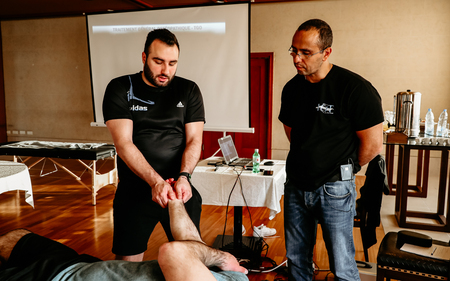
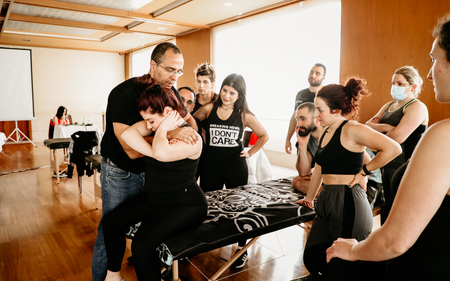
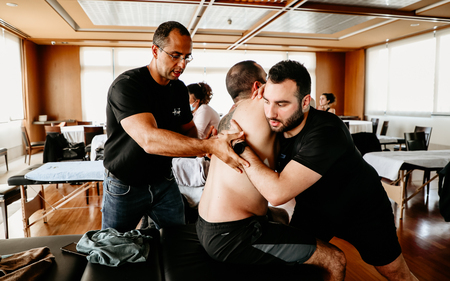
Diagnosis of somatic dysfunction
Diagnosis of somatic dysfunction is derived from structural examination to identify at least one of four diagnostic criteria described by the mnemonic TART (tissue texture abnormality, asymmetry, restriction of motion, and tenderness). Somatic dysfunction can be described as position of a body part, direction of free motion, or direction of restricted motion. For example, limited ankle dorsiflexion after a sprained ankle could be termed an anterior talus, ankle plantar flexion, or restricted ankle dorsiflexion. Each of these terms describes ankle somatic dysfunction. The Pocket Manual of OMT utilizes restricted motion terminology when relevant because it is more readily understood by practitioners other than osteopathic physicians.
Structural examination
Structural examination consists of screening the body to identify a region with somatic dysfunction, scanning to identify its location within the region, and local diagnosis to precisely define the somatic dysfunction. Screening tests, including postural exam and gait analysis to identify regional asymmetry, are presented in Chapter 2. Scanning tests and diagnosis skills are presented in subsequent chapters covering the 10 regions of somatic dysfunction: lower extremity, pelvis, sacrum, lumbar, thoracic, rib, upper extremity, cervical, head, and abdominal/other (visceral).
INDICATIONS FOR OMT
Osteopathic manipulative treatment is defined as the therapeutic application of manually guided forces by an osteopathic physician (U.S. usage) to improve physiologic function and/or support homeostasis that have been altered by somatic dysfunction.1 OMT is indicated whenever the practitioner makes the diagnosis of somatic dysfunction and relates it to a patient’s problem. Systematic reviews have demonstrated efficacy of manipulation, in general, for back pain, neck pain, and headache. Other conditions amenable to OMT are supported by small studies or clinical observation and are listed for each technique in subsequent chapters.
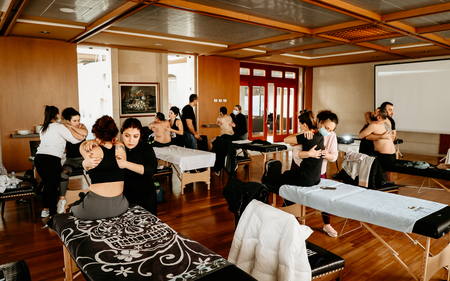
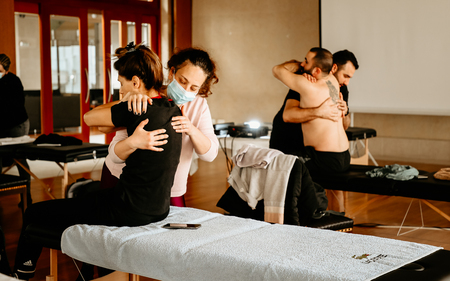
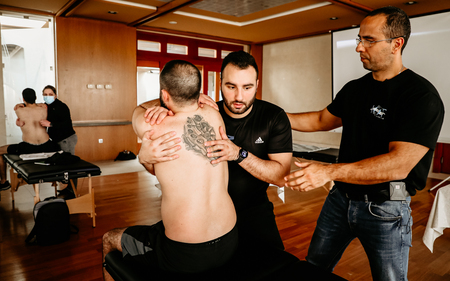
CONTRAINDICATIONS TO OMT
The only absolute contraindications to all OMT are absence of somatic dysfunction and patient’s desire not to have treatment. An individual technique is contraindicated when its potential benefit is outweighed by the risk of harm to the patient. Indirect techniques in which the body is moved away from a restriction and into a position of tissue laxity incur less risk for patients with acute injuries, severe illnesses, undiagnosed problems, or fragile conditions. Direct techniques in which the body is moved into a restriction are less applicable under these circumstances but are effective and safe for most chronic conditions. Relative contraindications are technique specific and are listed for each treatment presented in subsequent chapters.
OMT TECHNIQUES:
Each type of manipulative treatment has principles of application that can be applied to any part of the body based on practitioner’s knowledge of anatomy and function.
INDIRECT TECHNIQUES (move body into position of laxity to facilitate neurological resetting and local tissue relaxation)
Counterstrain: A system of diagnosis and treatment developed by Lawrence
Jones, DO, which considers the dysfunction to be a continuing, inappropriate strain reflex that is inhibited by applying a position of mild strain in the direction exactly opposite to that of the reflex. This is accomplished by specific directed positioning about the point of tenderness to achieve the desired therapeutic response.1
- Identify and label tender point as 10/10 or 100%;
- Passively position the body into tissue laxity and retest for tenderness, fine tuning in all planes of motion until tenderness is minimized to 0/10 if possible but at most 3/10;
- Hold this position of maximum relief for 90 seconds (120 seconds for ribs), maintaining finger contact to monitor for tissue texture changes but reducing pressure;
- Slowly and passively return the body to neutral;
- Retest for tenderness with the same pressure as initial labeling and retreat if not improved
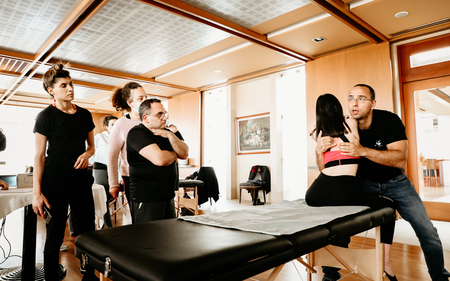
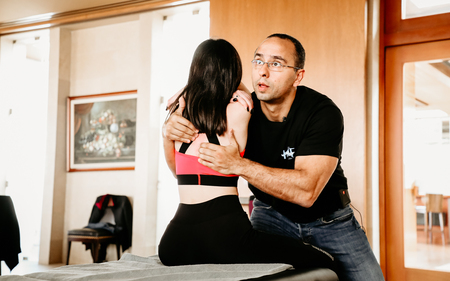
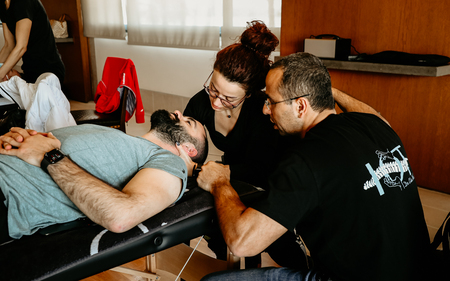
Ligamentous Articular Strain
A manipulative technique described by Howard Lippincott, DO and Rebecca Lippincott, DO in which the goal of treatment is to balance the tension in opposing ligaments where abnormal tension is present:
- Identify ligament or myofascial tension;
- Press into or apply traction to the tense area to engage the tissues;
- Slowly move the part of the body into its position of laxity for all planes;
- Maintain the position of laxity using balanced pressure and follow any tissue release until completed or inherent motion (cranial rhythmic impulse) is palpated;
- Retest for tension.
DIRECT TECHNIQUES (move body into restriction to facilitate improved motion)
Muscle Energy: A form of osteopathic manipulative diagnosis and treatment developed by Fred Mitchell Sr, DO in which the patient’s muscles are actively used on request, from a precisely controlled position, in a specific direction, and against a distinctly executed physician counterforce:
- Identify restricted joint movement for all possible planes of motion;
- Move the joint into its restriction for all planes;
- Have the patient push away from the restriction against equal physician resistance for 3–5 seconds;
- Allow full relaxation and then slowly move the joint to a new restrictive barrier;
- Repeat isometric contraction and stretch 3–5 times;
- Retest motion.
Soft Tissue: A direct technique that usually involves lateral stretching, linear stretching, deep pressure, traction, and/or separation of muscle origin and insertion while monitoring tissue response and motion changes by palpation.1
- Identify tension or edema;
- Apply force to the tense or edematous tissues by:
- Longitudinal stretch (traction);
- Kneading (lateral stretch);
- Inhibition (sustained pressure);
- Effleurage (stroking pressure);
- Petrissage (squeezing pressure);
- Retest for tension or edema.
Thrust: An osteopathic technique employing a rapid, therapeutic force of brief duration that travels a short distance within the anatomic range of motion of a joint, and that engages the restrictive barrier in one or more planes of motion to elicit release of restriction. Also known as high velocity low amplitude (HVLA):
- Identify restricted joint movement for all possible planes of motion;
- Move the joint into its restriction for all planes;
- Apply a short quick thrust through one of the restricted joint planes;
- Retest motion.
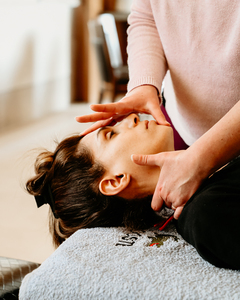
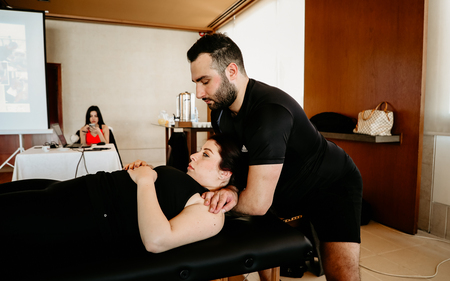
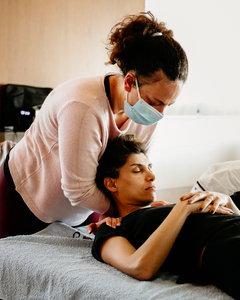
Facilitated Positional Release
A system of indirect myofascial release treatment developed by Stanley Schiowitz, DO. The component region of the body is placed into a neutral position, diminishing tissue and joint tension in all planes, and an activating force (compression or torsion) is added:
- Identify tension related to restricted motion;
- Place the joint or region in its neutral position;
- Palpate the tension and move the joint or region into its position of laxity for all planes;
- Add compression or torsion to facilitate tissue laxity;
- Hold the position of laxity for 3–5 seconds until tension release is completed and then slowly return to neutral;
- Retest for tension or motion.
COMBINED TECHNIQUES (use both indirect and direct mechanisms)
Articulatory: A low velocity/moderate-to-high amplitude technique in which a joint is carried through its full motion, with the therapeutic goal of increased freedom of range of movement. The activating force is either a repetitive springing motion or repetitive concentric movement of the joint through the restrictive barrier:
- Identify restricted joint movement for all possible planes of motion;
- Slowly move the joint to its position of laxity for all planes;
- Slowly move the joint into its restriction for all planes;
- Repeat as one smooth movement 3–5 times until joint mobility returns;
- Retest motion.
Facilitated Oscillatory Release: A manipulative technique developed by Zachary J. Comeaux, DO that applies manual oscillatory force to normalize neuromuscular function, intended to be combined with any treatment involving ligamentous or myofascial techniques:
- Identify tension and asymmetry related to restricted motion;
- Initiate stretch and oscillatory motion of the region of restriction using some tissue mass to initiate a standing (harmonic) wave;
- Monitor the quality of motion response in the tissues to further localize restriction;
- Continue rhythmic oscillation or modify its force until tension is reduced or rhythmic mobility improves. Other corrective force may be combined;
- Retest for tension or motion restriction.
Myofascial Release: A system of diagnosis and treatment first described by Andrew
- Still and his early students that engages continual palpatory feedback to achieve release of myofascial tissues.
- Identify restricted tissue or joint movement for all possible planes of motion;
- Indirect: Slowly move the part of the body into its position of laxity for all planes and follow any tissue release until completed;
- Direct: Slowly move the part of the body into its restrictions for all planes and apply steady force until tissue give is completed;
- Retest motion.
Osteopathy in the Cranial Field (cranial): A system of diagnosis and treatment first described by William G. Sutherland, DO and applied by an osteopathic practitioner using the primary respiratory mechanism and balanced membranous tension.Primary Respiratory Mechanism: A conceptual model that describes a process involving five interactive, involuntary functions: (1) The inherent motility of the brain and spinal cord, (2) fluctuation of the cerebrospinal fluid, (3) mobility of the intracranial and intraspinal membranes, (4) articular mobility of the cranial bones, and (5) mobility of the sacrum between the ilia (pelvic bones) that is interdependent with the motion at the sphenobasilar synchondrosis.
Seated Facet Release: A system of diagnosis and treatment taught to one of the authors (KMS) by Richard H. Still Jr, DO, great-grandson of Andrew T. Still, MD, DO, in which the patient is seated and the practitioner stands or sits behind him or her. The patient is guided into the position of greatest tension for a restricted open or closed facet. Then compression or distraction is introduced to that individual facet causing release of the restriction.
- Stand or sit behind the seated patient;
- Let the patient increase lordosis or kyphosis to balance the shoulders over the pelvis for lower spine and sacroiliac areas, or lean against you for upper spine and rib areas;
- Place a knuckle or finger on the inferior facet of the locked open or locked closed facet group;
- Place your other hand on the shoulder or head and gently compress inferiorly while extending the involved spinal or rib region, keeping the shoulders balanced over the pelvis for lower spine and sacroiliac areas or the patient leaning against you for upper spine and rib areas;
- Test for the position of greatest restriction by gentle compression and recoil to close and open the locked facet;
- Hold the patient in the position of greatest restriction and gently apply a small amount of additional compression or traction to induce glide of the facet, thereby releasing the restriction;
- Retest motion.
Visceral: A system of diagnosis and treatment directed to the viscera to improve physiologic function; typically the viscera are moved toward their fascial attachments to a point of fascial balance; also called ventral techniques.
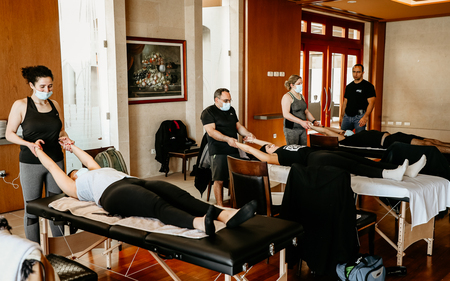
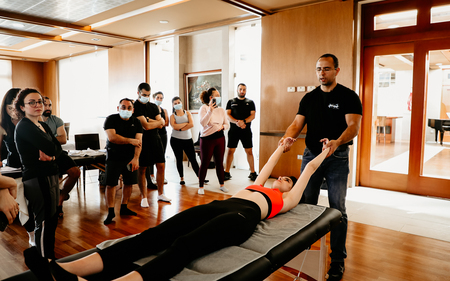
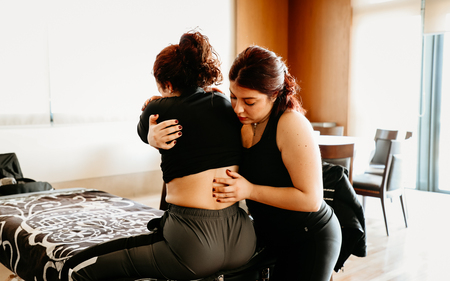
OTHER TECHNIQUES (do not use barrier concept as a treatment principle)
Lymphatic Pump: A term used to describe the impact of intrathoracic pressure changes on lymphatic flow. This was the name originally given to the thoracic pump technique before the more extensive physiologic effects of the technique were recognized.
Percussion Vibrator: A manipulative technique developed by Robert Fulford, DO involving the specific application of mechanical vibratory force to treat somatic dysfunction.
- Identify tension or restricted movement;
- Place the percussion pad on an associated bony prominence with the pad oriented perpendicular to the surface;
- Alter pad speed, pressure, and angle until vibrations are palpated as strong by a monitoring hand placed on the opposite side of the tension or restriction;
- Maintain contact until the force and rhythm of vibrations return to that of normal tissue;
- Alternate technique:
- Allow the monitoring hand to be pulled toward the pad, resisting any other direction of pull;
- Maintain percussion until the monitoring hand is pushed away from the pad;
- Slowly release the monitoring hand and percussor pad and retest for tension or restriction.
Somatovisceral Reflexes: A localized somatic stimulation producing patterns of reflex response in segmentally related visceral structures. Treatment techniques for sympathetic normalization include rib raising, thoracolumbar inhibition, abdominal plexus release, Chapman point stimulation, and treatment of thoracolumbar facilitated segments. Techniques for parasympathetic normalization include suboccipital inhibition or other occipitoatlantal treatments and sacral rocking or other sacroiliac treatments.
EXERCISE TECHNIQUES: Exercises derived from structural exam and OMT are presented after their corresponding treatment techniques.12 Type of exercise prescribed depends on the patient assessment, somatic dysfunction present, contraindications present, and response to OMT.
Position of Ease: Resting in a position for shortening of tense tissues for 2–5 minutes to bring about relaxation and decrease pain; useful for myofascial tenderness associated with acute problems as well as pain relief for subacute and chronic problems; Contraindicated for acute fractures.
Stretching: A steady movement into a restriction for 10–20 seconds to reduce tension and restore motion; useful for tension associated with subacute and chronic problems; contraindicated for acute sprains, acute fractures, or joint instability.
Self-Mobilization: A short and quick or slow and repetitive movement into a restriction to restore joint mobility; useful for joint restrictions associated with subacute and chronic problems; contraindicated for acute sprains, acute fractures, joint instability, inflammation, severe degeneration, or severe osteoporosis.
Postural Strengthening: A contraction of postural muscles against gravitational resistance until fatigued and repeated every other day to restore strength for standing and walking.
PRESCRIBING OMT: Each treatment plan depends upon the patient’s preference, physician’s skill, history, exam findings, indications, contraindications, and response to treatment. Exercises, orthotics, braces, and thermal therapy can be prescribed to complement the effectiveness of OMT. Cold packs can be applied for 15–20 minutes to inflamed or painful areas to reduce swelling and pain. Hot packs can be applied for 20–30 minutes before or after treatment or exercise to reduce tension, stiffness, and ache. Pain due to hypermobility or ligamentous laxity can be temporarily reduced with indirect methods of manipulation but is better treated with stabilization techniques such as bracing, strengthening, and prolotherapy. The latter, also called sclerotherapy, uses injection of a proliferant solution into weakened ligaments to strengthen or shorten the lax tissues.13 The prescription of OMT is an art in which the physician uses structural diagnosis and appropriate treatment to improve the patient’s functioning so that healing may occur more readily.
Osteopathic manipulative treatment (OMT) is used to treat a patient’s problem associated with somatic dysfunction: impaired or altered function of related components of the somatic (body framework) system—skeletal, arthrodial, and myofascial structures, and related vascular, lymphatic, and neural elements.



Diagnosis of somatic dysfunction
Diagnosis of somatic dysfunction is derived from structural examination to identify at least one of four diagnostic criteria described by the mnemonic TART (tissue texture abnormality, asymmetry, restriction of motion, and tenderness). Somatic dysfunction can be described as position of a body part, direction of free motion, or direction of restricted motion. For example, limited ankle dorsiflexion after a sprained ankle could be termed an anterior talus, ankle plantar flexion, or restricted ankle dorsiflexion. Each of these terms describes ankle somatic dysfunction. The Pocket Manual of OMT utilizes restricted motion terminology when relevant because it is more readily understood by practitioners other than osteopathic physicians.
Structural examination
Structural examination consists of screening the body to identify a region with somatic dysfunction, scanning to identify its location within the region, and local diagnosis to precisely define the somatic dysfunction. Screening tests, including postural exam and gait analysis to identify regional asymmetry, are presented in Chapter 2. Scanning tests and diagnosis skills are presented in subsequent chapters covering the 10 regions of somatic dysfunction: lower extremity, pelvis, sacrum, lumbar, thoracic, rib, upper extremity, cervical, head, and abdominal/other (visceral).
INDICATIONS FOR OMT
Osteopathic manipulative treatment is defined as the therapeutic application of manually guided forces by an osteopathic physician (U.S. usage) to improve physiologic function and/or support homeostasis that have been altered by somatic dysfunction.1 OMT is indicated whenever the practitioner makes the diagnosis of somatic dysfunction and relates it to a patient’s problem. Systematic reviews have demonstrated efficacy of manipulation, in general, for back pain, neck pain, and headache. Other conditions amenable to OMT are supported by small studies or clinical observation and are listed for each technique in subsequent chapters.



CONTRAINDICATIONS TO OMT
The only absolute contraindications to all OMT are absence of somatic dysfunction and patient’s desire not to have treatment. An individual technique is contraindicated when its potential benefit is outweighed by the risk of harm to the patient. Indirect techniques in which the body is moved away from a restriction and into a position of tissue laxity incur less risk for patients with acute injuries, severe illnesses, undiagnosed problems, or fragile conditions. Direct techniques in which the body is moved into a restriction are less applicable under these circumstances but are effective and safe for most chronic conditions. Relative contraindications are technique specific and are listed for each treatment presented in subsequent chapters.
OMT TECHNIQUES:
Each type of manipulative treatment has principles of application that can be applied to any part of the body based on practitioner’s knowledge of anatomy and function.
INDIRECT TECHNIQUES (move body into position of laxity to facilitate neurological resetting and local tissue relaxation)
Counterstrain: A system of diagnosis and treatment developed by Lawrence
Jones, DO, which considers the dysfunction to be a continuing, inappropriate strain reflex that is inhibited by applying a position of mild strain in the direction exactly opposite to that of the reflex. This is accomplished by specific directed positioning about the point of tenderness to achieve the desired therapeutic response.1
- Identify and label tender point as 10/10 or 100%;
- Passively position the body into tissue laxity and retest for tenderness, fine tuning in all planes of motion until tenderness is minimized to 0/10 if possible but at most 3/10;
- Hold this position of maximum relief for 90 seconds (120 seconds for ribs), maintaining finger contact to monitor for tissue texture changes but reducing pressure;
- Slowly and passively return the body to neutral;
- Retest for tenderness with the same pressure as initial labeling and retreat if not improved



Ligamentous Articular Strain
A manipulative technique described by Howard Lippincott, DO and Rebecca Lippincott, DO in which the goal of treatment is to balance the tension in opposing ligaments where abnormal tension is present:
- Identify ligament or myofascial tension;
- Press into or apply traction to the tense area to engage the tissues;
- Slowly move the part of the body into its position of laxity for all planes;
- Maintain the position of laxity using balanced pressure and follow any tissue release until completed or inherent motion (cranial rhythmic impulse) is palpated;
- Retest for tension.
DIRECT TECHNIQUES (move body into restriction to facilitate improved motion)
Muscle Energy: A form of osteopathic manipulative diagnosis and treatment developed by Fred Mitchell Sr, DO in which the patient’s muscles are actively used on request, from a precisely controlled position, in a specific direction, and against a distinctly executed physician counterforce:
- Identify restricted joint movement for all possible planes of motion;
- Move the joint into its restriction for all planes;
- Have the patient push away from the restriction against equal physician resistance for 3–5 seconds;
- Allow full relaxation and then slowly move the joint to a new restrictive barrier;
- Repeat isometric contraction and stretch 3–5 times;
- Retest motion.
Soft Tissue: A direct technique that usually involves lateral stretching, linear stretching, deep pressure, traction, and/or separation of muscle origin and insertion while monitoring tissue response and motion changes by palpation.1
- Identify tension or edema;
- Apply force to the tense or edematous tissues by:
- Longitudinal stretch (traction);
- Kneading (lateral stretch);
- Inhibition (sustained pressure);
- Effleurage (stroking pressure);
- Petrissage (squeezing pressure);
- Retest for tension or edema.
Thrust: An osteopathic technique employing a rapid, therapeutic force of brief duration that travels a short distance within the anatomic range of motion of a joint, and that engages the restrictive barrier in one or more planes of motion to elicit release of restriction. Also known as high velocity low amplitude (HVLA):
- Identify restricted joint movement for all possible planes of motion;
- Move the joint into its restriction for all planes;
- Apply a short quick thrust through one of the restricted joint planes;
- Retest motion.



Facilitated Positional Release
A system of indirect myofascial release treatment developed by Stanley Schiowitz, DO. The component region of the body is placed into a neutral position, diminishing tissue and joint tension in all planes, and an activating force (compression or torsion) is added:
- Identify tension related to restricted motion;
- Place the joint or region in its neutral position;
- Palpate the tension and move the joint or region into its position of laxity for all planes;
- Add compression or torsion to facilitate tissue laxity;
- Hold the position of laxity for 3–5 seconds until tension release is completed and then slowly return to neutral;
- Retest for tension or motion.
COMBINED TECHNIQUES (use both indirect and direct mechanisms)
Articulatory: A low velocity/moderate-to-high amplitude technique in which a joint is carried through its full motion, with the therapeutic goal of increased freedom of range of movement. The activating force is either a repetitive springing motion or repetitive concentric movement of the joint through the restrictive barrier:
- Identify restricted joint movement for all possible planes of motion;
- Slowly move the joint to its position of laxity for all planes;
- Slowly move the joint into its restriction for all planes;
- Repeat as one smooth movement 3–5 times until joint mobility returns;
- Retest motion.
Facilitated Oscillatory Release: A manipulative technique developed by Zachary J. Comeaux, DO that applies manual oscillatory force to normalize neuromuscular function, intended to be combined with any treatment involving ligamentous or myofascial techniques:
- Identify tension and asymmetry related to restricted motion;
- Initiate stretch and oscillatory motion of the region of restriction using some tissue mass to initiate a standing (harmonic) wave;
- Monitor the quality of motion response in the tissues to further localize restriction;
- Continue rhythmic oscillation or modify its force until tension is reduced or rhythmic mobility improves. Other corrective force may be combined;
- Retest for tension or motion restriction.
Myofascial Release: A system of diagnosis and treatment first described by Andrew
- Still and his early students that engages continual palpatory feedback to achieve release of myofascial tissues.
- Identify restricted tissue or joint movement for all possible planes of motion;
- Indirect: Slowly move the part of the body into its position of laxity for all planes and follow any tissue release until completed;
- Direct: Slowly move the part of the body into its restrictions for all planes and apply steady force until tissue give is completed;
- Retest motion.
Osteopathy in the Cranial Field (cranial): A system of diagnosis and treatment first described by William G. Sutherland, DO and applied by an osteopathic practitioner using the primary respiratory mechanism and balanced membranous tension.Primary Respiratory Mechanism: A conceptual model that describes a process involving five interactive, involuntary functions: (1) The inherent motility of the brain and spinal cord, (2) fluctuation of the cerebrospinal fluid, (3) mobility of the intracranial and intraspinal membranes, (4) articular mobility of the cranial bones, and (5) mobility of the sacrum between the ilia (pelvic bones) that is interdependent with the motion at the sphenobasilar synchondrosis.
Seated Facet Release: A system of diagnosis and treatment taught to one of the authors (KMS) by Richard H. Still Jr, DO, great-grandson of Andrew T. Still, MD, DO, in which the patient is seated and the practitioner stands or sits behind him or her. The patient is guided into the position of greatest tension for a restricted open or closed facet. Then compression or distraction is introduced to that individual facet causing release of the restriction.
- Stand or sit behind the seated patient;
- Let the patient increase lordosis or kyphosis to balance the shoulders over the pelvis for lower spine and sacroiliac areas, or lean against you for upper spine and rib areas;
- Place a knuckle or finger on the inferior facet of the locked open or locked closed facet group;
- Place your other hand on the shoulder or head and gently compress inferiorly while extending the involved spinal or rib region, keeping the shoulders balanced over the pelvis for lower spine and sacroiliac areas or the patient leaning against you for upper spine and rib areas;
- Test for the position of greatest restriction by gentle compression and recoil to close and open the locked facet;
- Hold the patient in the position of greatest restriction and gently apply a small amount of additional compression or traction to induce glide of the facet, thereby releasing the restriction;
- Retest motion.
Visceral: A system of diagnosis and treatment directed to the viscera to improve physiologic function; typically the viscera are moved toward their fascial attachments to a point of fascial balance; also called ventral techniques.



OTHER TECHNIQUES (do not use barrier concept as a treatment principle)
Lymphatic Pump: A term used to describe the impact of intrathoracic pressure changes on lymphatic flow. This was the name originally given to the thoracic pump technique before the more extensive physiologic effects of the technique were recognized.
Percussion Vibrator: A manipulative technique developed by Robert Fulford, DO involving the specific application of mechanical vibratory force to treat somatic dysfunction.
- Identify tension or restricted movement;
- Place the percussion pad on an associated bony prominence with the pad oriented perpendicular to the surface;
- Alter pad speed, pressure, and angle until vibrations are palpated as strong by a monitoring hand placed on the opposite side of the tension or restriction;
- Maintain contact until the force and rhythm of vibrations return to that of normal tissue;
- Alternate technique:
- Allow the monitoring hand to be pulled toward the pad, resisting any other direction of pull;
- Maintain percussion until the monitoring hand is pushed away from the pad;
- Slowly release the monitoring hand and percussor pad and retest for tension or restriction.
Somatovisceral Reflexes: A localized somatic stimulation producing patterns of reflex response in segmentally related visceral structures. Treatment techniques for sympathetic normalization include rib raising, thoracolumbar inhibition, abdominal plexus release, Chapman point stimulation, and treatment of thoracolumbar facilitated segments. Techniques for parasympathetic normalization include suboccipital inhibition or other occipitoatlantal treatments and sacral rocking or other sacroiliac treatments.
EXERCISE TECHNIQUES: Exercises derived from structural exam and OMT are presented after their corresponding treatment techniques.12 Type of exercise prescribed depends on the patient assessment, somatic dysfunction present, contraindications present, and response to OMT.
Position of Ease: Resting in a position for shortening of tense tissues for 2–5 minutes to bring about relaxation and decrease pain; useful for myofascial tenderness associated with acute problems as well as pain relief for subacute and chronic problems; Contraindicated for acute fractures.
Stretching: A steady movement into a restriction for 10–20 seconds to reduce tension and restore motion; useful for tension associated with subacute and chronic problems; contraindicated for acute sprains, acute fractures, or joint instability.
Self-Mobilization: A short and quick or slow and repetitive movement into a restriction to restore joint mobility; useful for joint restrictions associated with subacute and chronic problems; contraindicated for acute sprains, acute fractures, joint instability, inflammation, severe degeneration, or severe osteoporosis.
Postural Strengthening: A contraction of postural muscles against gravitational resistance until fatigued and repeated every other day to restore strength for standing and walking.
PRESCRIBING OMT: Each treatment plan depends upon the patient’s preference, physician’s skill, history, exam findings, indications, contraindications, and response to treatment. Exercises, orthotics, braces, and thermal therapy can be prescribed to complement the effectiveness of OMT. Cold packs can be applied for 15–20 minutes to inflamed or painful areas to reduce swelling and pain. Hot packs can be applied for 20–30 minutes before or after treatment or exercise to reduce tension, stiffness, and ache. Pain due to hypermobility or ligamentous laxity can be temporarily reduced with indirect methods of manipulation but is better treated with stabilization techniques such as bracing, strengthening, and prolotherapy. The latter, also called sclerotherapy, uses injection of a proliferant solution into weakened ligaments to strengthen or shorten the lax tissues.13 The prescription of OMT is an art in which the physician uses structural diagnosis and appropriate treatment to improve the patient’s functioning so that healing may occur more readily.
Osteopathic manipulative treatment (OMT) is used to treat a patient’s problem associated with somatic dysfunction: impaired or altered function of related components of the somatic (body framework) system—skeletal, arthrodial, and myofascial structures, and related vascular, lymphatic, and neural elements.



Diagnosis of somatic dysfunction
Diagnosis of somatic dysfunction is derived from structural examination to identify at least one of four diagnostic criteria described by the mnemonic TART (tissue texture abnormality, asymmetry, restriction of motion, and tenderness). Somatic dysfunction can be described as position of a body part, direction of free motion, or direction of restricted motion. For example, limited ankle dorsiflexion after a sprained ankle could be termed an anterior talus, ankle plantar flexion, or restricted ankle dorsiflexion. Each of these terms describes ankle somatic dysfunction. The Pocket Manual of OMT utilizes restricted motion terminology when relevant because it is more readily understood by practitioners other than osteopathic physicians.
Structural examination
Structural examination consists of screening the body to identify a region with somatic dysfunction, scanning to identify its location within the region, and local diagnosis to precisely define the somatic dysfunction. Screening tests, including postural exam and gait analysis to identify regional asymmetry, are presented in Chapter 2. Scanning tests and diagnosis skills are presented in subsequent chapters covering the 10 regions of somatic dysfunction: lower extremity, pelvis, sacrum, lumbar, thoracic, rib, upper extremity, cervical, head, and abdominal/other (visceral).
INDICATIONS FOR OMT
Osteopathic manipulative treatment is defined as the therapeutic application of manually guided forces by an osteopathic physician (U.S. usage) to improve physiologic function and/or support homeostasis that have been altered by somatic dysfunction.1 OMT is indicated whenever the practitioner makes the diagnosis of somatic dysfunction and relates it to a patient’s problem. Systematic reviews have demonstrated efficacy of manipulation, in general, for back pain, neck pain, and headache. Other conditions amenable to OMT are supported by small studies or clinical observation and are listed for each technique in subsequent chapters.



CONTRAINDICATIONS TO OMT
The only absolute contraindications to all OMT are absence of somatic dysfunction and patient’s desire not to have treatment. An individual technique is contraindicated when its potential benefit is outweighed by the risk of harm to the patient. Indirect techniques in which the body is moved away from a restriction and into a position of tissue laxity incur less risk for patients with acute injuries, severe illnesses, undiagnosed problems, or fragile conditions. Direct techniques in which the body is moved into a restriction are less applicable under these circumstances but are effective and safe for most chronic conditions. Relative contraindications are technique specific and are listed for each treatment presented in subsequent chapters.
OMT TECHNIQUES:
Each type of manipulative treatment has principles of application that can be applied to any part of the body based on practitioner’s knowledge of anatomy and function.
INDIRECT TECHNIQUES (move body into position of laxity to facilitate neurological resetting and local tissue relaxation)
Counterstrain: A system of diagnosis and treatment developed by Lawrence
Jones, DO, which considers the dysfunction to be a continuing, inappropriate strain reflex that is inhibited by applying a position of mild strain in the direction exactly opposite to that of the reflex. This is accomplished by specific directed positioning about the point of tenderness to achieve the desired therapeutic response.1
- Identify and label tender point as 10/10 or 100%;
- Passively position the body into tissue laxity and retest for tenderness, fine tuning in all planes of motion until tenderness is minimized to 0/10 if possible but at most 3/10;
- Hold this position of maximum relief for 90 seconds (120 seconds for ribs), maintaining finger contact to monitor for tissue texture changes but reducing pressure;
- Slowly and passively return the body to neutral;
- Retest for tenderness with the same pressure as initial labeling and retreat if not improved



Ligamentous Articular Strain
A manipulative technique described by Howard Lippincott, DO and Rebecca Lippincott, DO in which the goal of treatment is to balance the tension in opposing ligaments where abnormal tension is present:
- Identify ligament or myofascial tension;
- Press into or apply traction to the tense area to engage the tissues;
- Slowly move the part of the body into its position of laxity for all planes;
- Maintain the position of laxity using balanced pressure and follow any tissue release until completed or inherent motion (cranial rhythmic impulse) is palpated;
- Retest for tension.
DIRECT TECHNIQUES (move body into restriction to facilitate improved motion)
Muscle Energy: A form of osteopathic manipulative diagnosis and treatment developed by Fred Mitchell Sr, DO in which the patient’s muscles are actively used on request, from a precisely controlled position, in a specific direction, and against a distinctly executed physician counterforce:
- Identify restricted joint movement for all possible planes of motion;
- Move the joint into its restriction for all planes;
- Have the patient push away from the restriction against equal physician resistance for 3–5 seconds;
- Allow full relaxation and then slowly move the joint to a new restrictive barrier;
- Repeat isometric contraction and stretch 3–5 times;
- Retest motion.
Soft Tissue: A direct technique that usually involves lateral stretching, linear stretching, deep pressure, traction, and/or separation of muscle origin and insertion while monitoring tissue response and motion changes by palpation.1
- Identify tension or edema;
- Apply force to the tense or edematous tissues by:
- Longitudinal stretch (traction);
- Kneading (lateral stretch);
- Inhibition (sustained pressure);
- Effleurage (stroking pressure);
- Petrissage (squeezing pressure);
- Retest for tension or edema.
Thrust: An osteopathic technique employing a rapid, therapeutic force of brief duration that travels a short distance within the anatomic range of motion of a joint, and that engages the restrictive barrier in one or more planes of motion to elicit release of restriction. Also known as high velocity low amplitude (HVLA):
- Identify restricted joint movement for all possible planes of motion;
- Move the joint into its restriction for all planes;
- Apply a short quick thrust through one of the restricted joint planes;
- Retest motion.



Facilitated Positional Release
A system of indirect myofascial release treatment developed by Stanley Schiowitz, DO. The component region of the body is placed into a neutral position, diminishing tissue and joint tension in all planes, and an activating force (compression or torsion) is added:
- Identify tension related to restricted motion;
- Place the joint or region in its neutral position;
- Palpate the tension and move the joint or region into its position of laxity for all planes;
- Add compression or torsion to facilitate tissue laxity;
- Hold the position of laxity for 3–5 seconds until tension release is completed and then slowly return to neutral;
- Retest for tension or motion.
COMBINED TECHNIQUES (use both indirect and direct mechanisms)
Articulatory: A low velocity/moderate-to-high amplitude technique in which a joint is carried through its full motion, with the therapeutic goal of increased freedom of range of movement. The activating force is either a repetitive springing motion or repetitive concentric movement of the joint through the restrictive barrier:
- Identify restricted joint movement for all possible planes of motion;
- Slowly move the joint to its position of laxity for all planes;
- Slowly move the joint into its restriction for all planes;
- Repeat as one smooth movement 3–5 times until joint mobility returns;
- Retest motion.
Facilitated Oscillatory Release: A manipulative technique developed by Zachary J. Comeaux, DO that applies manual oscillatory force to normalize neuromuscular function, intended to be combined with any treatment involving ligamentous or myofascial techniques:
- Identify tension and asymmetry related to restricted motion;
- Initiate stretch and oscillatory motion of the region of restriction using some tissue mass to initiate a standing (harmonic) wave;
- Monitor the quality of motion response in the tissues to further localize restriction;
- Continue rhythmic oscillation or modify its force until tension is reduced or rhythmic mobility improves. Other corrective force may be combined;
- Retest for tension or motion restriction.
Myofascial Release: A system of diagnosis and treatment first described by Andrew
- Still and his early students that engages continual palpatory feedback to achieve release of myofascial tissues.
- Identify restricted tissue or joint movement for all possible planes of motion;
- Indirect: Slowly move the part of the body into its position of laxity for all planes and follow any tissue release until completed;
- Direct: Slowly move the part of the body into its restrictions for all planes and apply steady force until tissue give is completed;
- Retest motion.
Osteopathy in the Cranial Field (cranial): A system of diagnosis and treatment first described by William G. Sutherland, DO and applied by an osteopathic practitioner using the primary respiratory mechanism and balanced membranous tension.Primary Respiratory Mechanism: A conceptual model that describes a process involving five interactive, involuntary functions: (1) The inherent motility of the brain and spinal cord, (2) fluctuation of the cerebrospinal fluid, (3) mobility of the intracranial and intraspinal membranes, (4) articular mobility of the cranial bones, and (5) mobility of the sacrum between the ilia (pelvic bones) that is interdependent with the motion at the sphenobasilar synchondrosis.
Seated Facet Release: A system of diagnosis and treatment taught to one of the authors (KMS) by Richard H. Still Jr, DO, great-grandson of Andrew T. Still, MD, DO, in which the patient is seated and the practitioner stands or sits behind him or her. The patient is guided into the position of greatest tension for a restricted open or closed facet. Then compression or distraction is introduced to that individual facet causing release of the restriction.
- Stand or sit behind the seated patient;
- Let the patient increase lordosis or kyphosis to balance the shoulders over the pelvis for lower spine and sacroiliac areas, or lean against you for upper spine and rib areas;
- Place a knuckle or finger on the inferior facet of the locked open or locked closed facet group;
- Place your other hand on the shoulder or head and gently compress inferiorly while extending the involved spinal or rib region, keeping the shoulders balanced over the pelvis for lower spine and sacroiliac areas or the patient leaning against you for upper spine and rib areas;
- Test for the position of greatest restriction by gentle compression and recoil to close and open the locked facet;
- Hold the patient in the position of greatest restriction and gently apply a small amount of additional compression or traction to induce glide of the facet, thereby releasing the restriction;
- Retest motion.
Visceral: A system of diagnosis and treatment directed to the viscera to improve physiologic function; typically the viscera are moved toward their fascial attachments to a point of fascial balance; also called ventral techniques.



OTHER TECHNIQUES (do not use barrier concept as a treatment principle)
Lymphatic Pump: A term used to describe the impact of intrathoracic pressure changes on lymphatic flow. This was the name originally given to the thoracic pump technique before the more extensive physiologic effects of the technique were recognized.
Percussion Vibrator: A manipulative technique developed by Robert Fulford, DO involving the specific application of mechanical vibratory force to treat somatic dysfunction.
- Identify tension or restricted movement;
- Place the percussion pad on an associated bony prominence with the pad oriented perpendicular to the surface;
- Alter pad speed, pressure, and angle until vibrations are palpated as strong by a monitoring hand placed on the opposite side of the tension or restriction;
- Maintain contact until the force and rhythm of vibrations return to that of normal tissue;
- Alternate technique:
- Allow the monitoring hand to be pulled toward the pad, resisting any other direction of pull;
- Maintain percussion until the monitoring hand is pushed away from the pad;
- Slowly release the monitoring hand and percussor pad and retest for tension or restriction.
Somatovisceral Reflexes: A localized somatic stimulation producing patterns of reflex response in segmentally related visceral structures. Treatment techniques for sympathetic normalization include rib raising, thoracolumbar inhibition, abdominal plexus release, Chapman point stimulation, and treatment of thoracolumbar facilitated segments. Techniques for parasympathetic normalization include suboccipital inhibition or other occipitoatlantal treatments and sacral rocking or other sacroiliac treatments.
EXERCISE TECHNIQUES: Exercises derived from structural exam and OMT are presented after their corresponding treatment techniques.12 Type of exercise prescribed depends on the patient assessment, somatic dysfunction present, contraindications present, and response to OMT.
Position of Ease: Resting in a position for shortening of tense tissues for 2–5 minutes to bring about relaxation and decrease pain; useful for myofascial tenderness associated with acute problems as well as pain relief for subacute and chronic problems; Contraindicated for acute fractures.
Stretching: A steady movement into a restriction for 10–20 seconds to reduce tension and restore motion; useful for tension associated with subacute and chronic problems; contraindicated for acute sprains, acute fractures, or joint instability.
Self-Mobilization: A short and quick or slow and repetitive movement into a restriction to restore joint mobility; useful for joint restrictions associated with subacute and chronic problems; contraindicated for acute sprains, acute fractures, joint instability, inflammation, severe degeneration, or severe osteoporosis.
Postural Strengthening: A contraction of postural muscles against gravitational resistance until fatigued and repeated every other day to restore strength for standing and walking.
PRESCRIBING OMT: Each treatment plan depends upon the patient’s preference, physician’s skill, history, exam findings, indications, contraindications, and response to treatment. Exercises, orthotics, braces, and thermal therapy can be prescribed to complement the effectiveness of OMT. Cold packs can be applied for 15–20 minutes to inflamed or painful areas to reduce swelling and pain. Hot packs can be applied for 20–30 minutes before or after treatment or exercise to reduce tension, stiffness, and ache. Pain due to hypermobility or ligamentous laxity can be temporarily reduced with indirect methods of manipulation but is better treated with stabilization techniques such as bracing, strengthening, and prolotherapy. The latter, also called sclerotherapy, uses injection of a proliferant solution into weakened ligaments to strengthen or shorten the lax tissues.13 The prescription of OMT is an art in which the physician uses structural diagnosis and appropriate treatment to improve the patient’s functioning so that healing may occur more readily.
